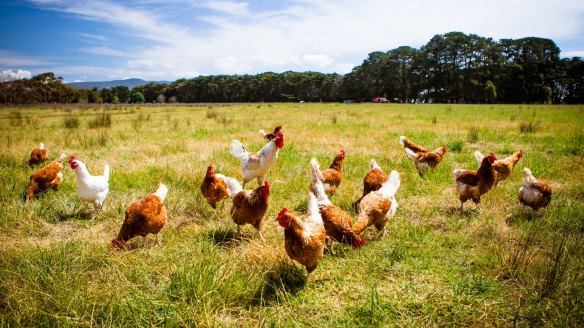Are there hormones in chickens we buy to eat?

Are there hormones in chickens we buy to eat? G. Clarke
Hormones in chicken have been associated with early onset puberty in children and the rise of man boobs. Yes, the chickens we eat are much larger than they were 50 years ago, and they do grow to be a great size in a very short period – 42 days from hatch to dispatch, in fact. They are raised in great barns and may be fed on a diet that may include bits of chickens not consumed by humans. There is a good chance they are given prophylactic antibiotics to stave off infection and help them grow faster. I've been to a few chook sheds where meat birds are raised, and some can be pretty horrible, stinking places. But, no Australian chicken is fed hormones. In the 1960s, cockerels were fed estrogen, which helped them lay down fat, but this did not help them put on extra muscle. This practice was outlawed, and it is illegal to feed meat chickens hormones in Australia. Hormones in chicken in Australia in recent years is an urban myth. It could be linked to a 1985 media report that girls in Puerto Rico were reaching puberty earlier, the finger being pointed at hormones in chicken. This story was later debunked. The irony in the hormones in chicken myth is that it is often repeated by the beef industry. Australian beef farmers regularly use hormone growth promotants (HGP) in their cattle. This is true not only of the feedlot industry but some growers of grass-fed cattle as well. Coles supermarkets eliminated HGP from their beef supplies in 2011, to much outrage from the beef industry. Hormones in chicken? No. Hormones in beef? Sometimes. Myth busted.
I love cranberry sauce with my Christmas turkey. Is it possible to buy Australian-grown fruit? L. McAllister
Cranberries are native to the cool-climate wetlands of Canada and the US. Anyone who has travelled the south of this great nation will be aware that we don't have many wetlands left in the south, most being drained for agriculture. As an aside, cranberries grow in the rich but acidic soils around wetlands, which are artificially flooded for harvest, causing the cranberries to float to the surface in a sea of red. From there they are skimmed off, sorted and processed. Every now and then you will see cranberries in farmers' markets at the end of autumn. If you are really enthusiastic about cranberries, you can buy the vines from diggers.com.au.
Letters
A few weeks back we were talking about opening stuck lids. L. Hanks (83), writes, "Hold the jar sideways. With some heavy implement, give the lid a few good whacks around the side rim (turning the jar incrementally while you hit it). This should help break the seal or loosen what is stuck, and make the lid easy to remove." Several British readers wanted to know where to find clementines, the seedless thin-skinned citrus popular in Britain at Christmas. They are a type of what we call mandarins here down under. L. Cummins is also from Britain and is looking for Brussels sprouts to celebrate Christmas. All I can say to L. Cummins is, welcome to Australia, it's summer. Enjoy the prawns, oysters, shellfish, berries and stone fruit. Frozen brussels sprouts can be found in the slightly dour frozen section of supermarkets.
Send your vexing culinary conundrums to brainfood@richardcornish.com.au or tweet to @realbrainfood
Read more: Think you're buying free-range, grass-fed, ethical meat? Look closer at the label
- More:
- Food
- Brain food
